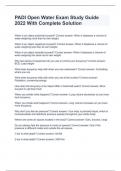Padi open water exam - Study guides, Class notes & Summaries
Looking for the best study guides, study notes and summaries about Padi open water exam? On this page you'll find 1005 study documents about Padi open water exam.
Page 3 out of 1.005 results
Sort by
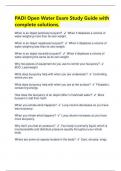
-
PADI (Professional Association of Diving Instructors) Open Water Diver Exams PACKAGE DEAL | BUNDLE contains the latest final exam solutions, practice test, test bank and updated study guide - Everything you need to pass is here.
- Package deal • 7 items • 2024
-
- $23.19
- 1x sold
- + learn more
PADI (Professional Association of Diving Instructors) Open Water Diver Exams PACKAGE DEAL | BUNDLE contains the latest final exam solutions, practice test, test bank and updated study guide - Everything you need to pass is here.
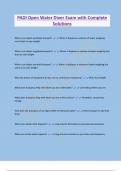
-
PADI Open Water Diver Exam with Complete Solutions
- Exam (elaborations) • 12 pages • 2024
- Available in package deal
-
- $13.99
- + learn more
PADI Open Water Diver Exam with Complete Solutions When is an object positively buoyant? When it displaces a volume of water weighing more than its own weight When is an object negatively buoyant? When it displaces a volume of water weighing less than its own weight When is an object neutrally buoyant? When it displaces a volume of water weighing the same as its own weight Why two pieces of equipment do you use to control your buoyancy? BCD, lead weight What does buoyancy help with ...
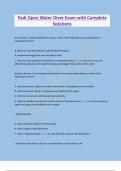
-
Padi Open Water Diver Exam with Complete Solutions
- Exam (elaborations) • 13 pages • 2024
- Available in package deal
-
- $12.99
- + learn more
Padi Open Water Diver Exam with Complete Solutions As I descend, I need to equalize air spaces. which of the following are accepted ways of equalizing my ears? A. block my nose and attempt to gently blow through it B. swallow and wiggle the jaw form side to side C. block my nose and blow forcefully for an extended period A. block my nose and attempt to gently blow through itB. swallow and wiggle the jaw form side to side during a descent, I try to equalize but discover I'm having tro...
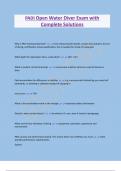
-
PADI Open Water Diver Exam with Complete Solutions
- Exam (elaborations) • 11 pages • 2024
- Available in package deal
-
- $12.99
- + learn more
PADI Open Water Diver Exam with Complete Solutions Why is PADI training important? must reduce/avoid hazards, accept risks and get a lot out of diving, certification shows qualification, this is needed for rental of scuba gear What depth for openwater dives, scuba diver? 18m. 12m What is student centred learning? course pace matches what you need to become a diver Padi accomodates for differences in abilities e.g. someone with limited leg use could roll backwards, or pivoting in side...
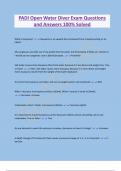
-
PADI Open Water Diver Exam Questions and Answers 100% Solved
- Exam (elaborations) • 13 pages • 2024
- Available in package deal
-
- $13.99
- + learn more
PADI Open Water Diver Exam Questions and Answers 100% Solved What is buoyancy? Buoyancy is an upward force produced from a liquid pushing on an object. My sunglasses case falls out of my pocket into the water, but fortunately, it floats so I retrieve it. I would say my sungalsses case is [blank] buoyant. Positively Salt water causes more buoyancy than fresh water because it is less dense and weighs less. True or false? False. Salt water causes more buoyancy because it is more dense an...
PADI Open Water Diver Exam Questions and Answers 2024.
PADI Open Water Exam Study Guide 2024 With Complete Solution
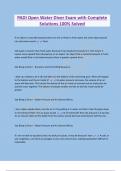
-
PADI Open Water Diver Exam with Complete Solutions 100% Solved
- Exam (elaborations) • 13 pages • 2024
- Available in package deal
-
- $13.99
- + learn more
PADI Open Water Diver Exam with Complete Solutions 100% Solved If an object is neutrally buoyant (does not sink or float) in fresh water, the same object placed into salt water would Float Salt water is heavier than fresh water because it has dissolved minerals in it. This means it causes more upward force (buoyancy) on an object. An object that is neutrally buoyant in fresh water would float in salt water because there is greater upward force. See Being a Diver I - Buoyancy and Contr...

-
PADI Open Water Diver Certification Exam Questions with correct Answers
- Exam (elaborations) • 12 pages • 2023
- Available in package deal
-
- $10.99
- 1x sold
- + learn more
PADI Open Water Diver Certification Exam Questions with correct Answers
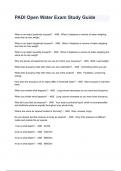
-
PADI Open Water Exam Study Guide Questions And Answers
- Exam (elaborations) • 9 pages • 2024
- Available in package deal
-
- $13.49
- + learn more
PADI Open Water Exam Study Guide Questions And Answers When is an object positively buoyant? - ANS When it displaces a volume of water weighing more than its own weight. When is an object negatively buoyant? - ANS When it displaces a volume of water weighing less than its own weight. When is an object neutrally buoyant? - ANS When it displaces a volume of water weighing the same as its own weight. Why two pieces of equipment do you use to control your buoyancy? - ANS B...

Did you know that on average a seller on Stuvia earns $82 per month selling study resources? Hmm, hint, hint. Discover all about earning on Stuvia




